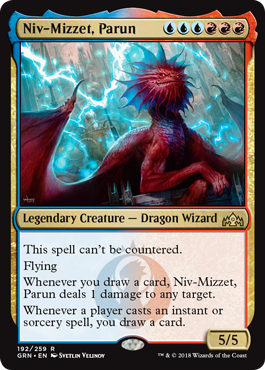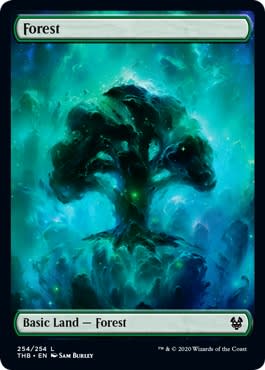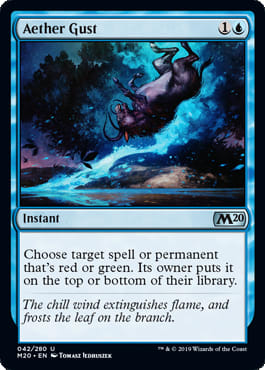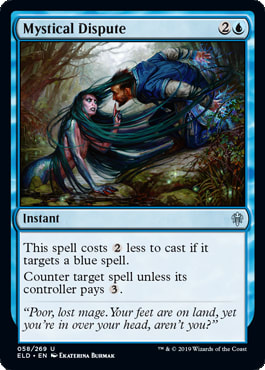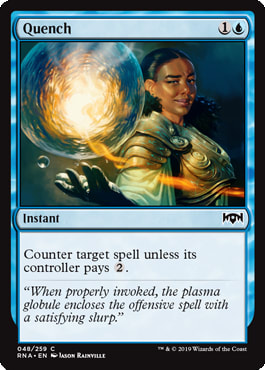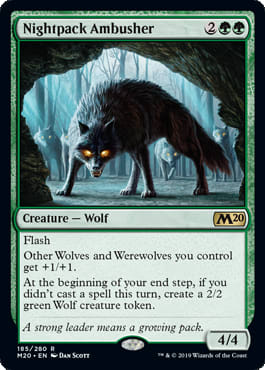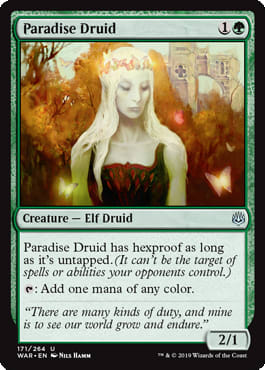Wars and Rumors of War
-Matthew 24:6
- Now that Oko, Thief of Crowns is banned, Jeskai Fires is the best deck.
- Jeskai Fires was the most popular deck at Mythic Championship VII.
- The Jeskai mirror is a slightly weighted coin flip.
- Simic Flash was the highest performing deck at Mythic Championship VII.
- Jeskai Fires cannot beat Simic Flash.
- Simic Flash cannot beat Jund Sacrifice.
- Because of its effectiveness against Simic Flash, now "everybody" is playing Jund Sacrifice.
I am not typically a man who chooses his Magic: The Gathering deck by turning to scripture; but this smelled an awful lot like Matthew's wars and rumors of wars.
What's a girl to do?
Not be alarmed?
Level Zero
New working hypothesis: Simic Flash and Jund Sacrifice are the default decks people will play. The task becomes identifying and then picking an otherwise adequate deck that beats both Simic Flash and Jund Sacrifice.
(Keep in mind I had no practical experience at this point RE: what I'm about to discuss next. Nor had I ever sleeved up Izzet Flash [though I had both played against and admired it].)
That said, I play a lot of Embercleave Mono-Red on MTG Arena, and I keep assassinating Jund Sacrifice decks. I received similar scouting reports from friends specializing on decks like Rakdos Knights. You can't necessarily disrupt their machinery; and they have a powerful top end. You can, nay must, go over, or through.
Izzet seemed like the most attractive candidate to me. It could play Embercleave but also control its draws in a way that Mono-Red and Rakdos could not. Izzet was mediocre heads up against Simic at Mythic Championship VII, but I had an almost irresistible new piece of technology.
Like anyone is beating big Niv!
Niv-Mizzet has a high likelihood of resolving against Simic. Not only can it not be countered normally, but Aether Gust (which can interact with Niv-Mizzet on the stack) is a low priority sideboard card in the matchup. Izzet just doesn't normally have cards you want to Aether Gust, outside of these enormous six-mana permanents that many Izzet Flash decks simply don't play.
I told my friend Patrick Chapin I dreamed of winning the PTQ with Niv-Mizzet wearing Embercleave.
With two over-the-top strategies for the perceived two best decks, I went to who I thought would probably be the world's preeminent expert in the field of Izzet Flash for advice: Gabriel Nassif.
The mighty Yellow Hat was not only the highest finishing Izzet Flash player at Mythic Championship VII, according to Next Level Deck-building, he's the second best deck designer of all time.
Nassif told me to just play Simic Flash, because Izzet was a mediocre Flash deck by comparison.
What Does Everybody Else Know That I Don't Know
Let's posit that, thanks to Hat, I'm now a Simic Flash player.
The new task is to figure out the Jund Sacrifice matchup, validate what everyone else (and the Mythic Championship numbers) are saying about the matchup, and then break some eggs.
Jund Sacrifice was meant to be the It Girl for the coming weekend, and posted a 63% win percentage against Simic Flash.
I was surprised to see rising popularity among top players not only around Jund Sacrifice but Simic Ramp. I tested both of those matchups extensively.
Simic Flash beat both decks Game 1!
If I said Simic Flash had an 80-85% likelihood to win Game 1 against Jund Sacrifice... I'm not sure how much of an exaggeration that is. The matchup was plain lopsided. Their high end of Casualties of War either never resolved or only resolved when I didn't care. They might take out my Nightpack Ambusher... But I'd either have a replacement or would welcome back my next turn to tap main phase for Nissa or a big Krasis. The Jund Sacrifice deck is so removal poor in Game 1, and its creatures are so small, they just got run over again and again by Simic Flash's extraordinary power level.
Speaking of extraordinary power level, Simic Ramp's could not contend with the smooth savvy of Simic Flash. Simic Ramp has the biggest Krasis all other things held equal, but Simic Flash's ability to contain Nissa, Who Shakes the World led to an even greater level of "lopsided" than Simic Flash v. Jeskai Fires.
The key to this matchup is that Simic Flash almost always has a mana edge. This might not make sense because Ramp has Risen Reef, but hear me out: Ramp can't two-spell.
At three or lower Ramp can fall victim to Quench. Once you're at four, Ramp only really has threes but Flash can upgrade to a Frilled Mystic. 3/2 ain't no joke in this matchup. Most games Ramp never keeps anything bigger than 1/1!
At six Ramp is still trying to land fives whereas Flash can not only Nissa into meaningfully open mana (Breeding Pool), Flash can two-spell Nightpack Ambusher AND another 2 mana card.
Then you just shift into "protect the queen" and ride into Game 2.
I have been grinding play-test games for literally decades. I don't know that I've ever seen so lopsided a field. Simic Flash absolutely crushed all of Simic Ramp, Jeskai Fires, and Jund Sacrifice Game 1. Mercilessly.
But people were registering other decks.
Did they not test?
Did they miss something really obvious?
Wait... Was I wrong? Did I miss something? It really didn't seem that way, but...
What does everybody else know that I don't know?
Let's talk about deck selection for a moment. Default in my career, I've generally just wanted to be "different". To paraphrase my long lost roommate Adrian Sullivan; not different for the sake of difference, different because difference wins. Based on Game 1 win expectation, it seemed ridiculous to me to play any other deck.
According to MTGGoldfish, the three most popular decks in Standard were 1) Jund Food, 2) Jeskai Fires, and 3) Simic Ramp... All of which are overwhelmingly in favor of Simic Flash.
Simic Flash itself is the fourth most popular deck; followed by Izzet (favorable at MCVII, and discouraged to me by its leading pilot) and Golgari Adventure (again wildly favorable to Simic Flash at MCVII).
What does everybody else know that I don't know?
The last time I qualified for the Pro Tour via a Pro Tour Qualifier, it was a Regional Pro Tour Qualifier in Utah. I flew to the freaking Mountain Time Zone to stay with my friends Jack Stanton and Pro Tour Top 8 competitor Aaron Muranaka and play this weird Five-color Mono-Blue Dragons deck that Patrick Chapin, Bryan Raymer, and Brian David-Marshall had helped me to brew.
I correctly predicted Esper Dragons and various flavors of Mono-Red would be the most popular opponents. I had never felt so prepared for any tournament. I correctly picked a deck that beat them both.
First round in Utah, I was paired with Atarka Red. The matchup I was arguably most ready for. I had Encase in Ice IN MY MAIN DECK.
In Game 2, I drew the Omenspeaker / Master of Waves sequence that the one and only Gerry Thompson had developed for me.
I lost that match in two games. To repeat: I drew the cards I was supposed to draw. And I lost in two.
It is difficult to describe the level of uncertainty and even shame that creeps over you in a moment like this.
I thought I was so smart.
I thought I was so clever.
Did I really fly all the way to Utah to go 0-2 with a homebrew?
I couldn't blame it on manascrew. How much of my family's money did I just blow on plane tickets? I drew the cards I was supposed to draw! And still lost!
I guess I didn't know something everyone else didn't.
And yet...
I rallied to beat two consecutive Mono-Red players in the next two rounds. Then back-to-back Temur. I hadn't prepared for Temur but both fell my way.
And then in the Top 8... Finally I was matched with Esper Dragons. I was top-half and would be on the play. At that point I knew I had already qualified. I just had to not cheat, draw extra cards, or flip a table.
In 2015 I did in fact know something some other people didn't know!
But in 2019, the deck selection thing still bugged me: What does everybody else know that I don't?
The Best Solutions
-Julian Casablancas
If there was something other folks knew that I didn't it was this:
Jund might have lost to Simic Flash Game 1, but its win percentage was largely carried by an excellent sideboard strategy. Kanister's plan included siding out expensive cards like Casualties of War in exchange for cheaper cards like Duress and Lovestruck Beast.
"This is a terrible strategy," I thought to myself. "Or at least one I'm not going to lose to."
The powerful, engine rich, Jund Cat Food deck would de-volve itself into an inefficient version of Golgari Adventures? How was that good?
Yet it turned out to be very good!
As badly as I was able to beat Jund in Game 1, they were manhandling me in sideboarded games. You can win 100% of Game 1s but if you lose 100% of sideboarded ones the matchup becomes hopeless. My expectation was that players would not only play more copies of Lovestruck Beast, they would be adding Shifting Ceratops!
5/4.
5/5.
Can't win.
Can't win... alone. But luckily I had the best deck designers in the history of Magic all on speed dial.
You can listen to Zvi Mowshowitz describe, himself, how he figured out a simple and unexpected solution to my problem here.
If they're bringing in 5/4 and 5/5... Why don't we just bring in 5/6?
Jund Cat Food doesn't have any combat tricks. They are notoriously removal poor, and their entire sideboarding strategy is predicated on taking out their powerful top end.
Cavalier of Thorns isn't going anywhere. In the unlikely case it dies, you just get back Nissa or Hydroid Krasis.
I also went to my Top Level Podcast partner Patrick Chapin for more ideas. Patrick suggested I try Kenrith's Transformation (which is what Brad and the World Champions used), as well as any powerful threats that helped me get ahead on the battlefield... Stuff like Mass Manipulation or Ugin, the Ineffable.
We tested a ton of sideboarded games. A ton.
I tried 4 Kenrith's Transformation, then 3 Kenrith's Transformation. Then I tried all my Kenrith's Transformations as Commence the Endgame. Until my absolutely essential play-test partner Ryan Fossella pointed out that Hydroid Krasis was almost always better on six.
The new plan was just to play big guys and hide behind them. I'd win the vast majority of games where I just played a fast Nightpack Ambusher... But Zvi's Cavaliers and various other large threats inspired by Patrick would hold the battlefield. Because Jund has so little real removal, that meant that Nissa would consistently have time and space to tick up.
I ended up winning about 50% of sideboarded games... Which is a heck of a lot better than the previous sideboards I tried. Next to my overwhelming Game 1, I felt like I would win the majority of Jund matches, especially given the implication that I would be on the play in Game 3.
Here's the deck:
Simic Flash | Eldraine Standard | Michael Flores
- Creatures (15)
- 2 Brazen Borrower
- 2 Hydroid Krasis
- 3 Paradise Druid
- 4 Frilled Mystic
- 4 Nightpack Ambusher
- Planeswalkers (4)
- 4 Nissa, Who Shakes the World
- Instants (15)
- 1 Negate
- 2 Aether Gust
- 2 Mystical Dispute
- 3 Quench
- 3 Sinister Sabotage
- 4 Growth Spiral
- Lands (26)
- 7 Forest
- 7 Island
- 2 Castle Vantress
- 2 Fabled Passage
- 4 Breeding Pool
- 4 Temple of Mystery
- Sideboard (15)
- 1 Ugin, the Ineffable
- 2 Aether Gust
- 2 Mystical Dispute
- 2 Hydroid Krasis
- 4 Cavalier of Thorns
- 2 Lovestruck Beast
- 2 Shifting Ceratops
In the Jund matchup you want nine in:
Take out 2 Mystical Disputes and a variety of permission.
The simplest choices are:
- -2 Mystical Dispute
- -3 Quench
- -4 Frilled Mystic
... But you might not want to do that. For instance I could make the case Quench is great on the play... but can also help catch up on the draw (I once Quenched a Mayhem Devil on turn five or six and it was backbreaking).
You don't need Frilled Mystic's body much, and Sinister Sabotage or even Negate can sometimes two-spell late in case they left in Casualties of War.
There's a lot of play to this game-to-game. If I always had to do the same thing every time I'd side as above, with one Negate out leaving one Quench.
Anyway, in case you missed it...
Greatest Deck-builder #2 Gabriel Nassif put me on my deck archetype, over the one he played himself.
Greatest Deck-builder #1 Zvi Mowshowitz fixed my sideboard, alongside...
The unrated "present company excepted" Innovator Patrick Chapin, who also contributed to the one aspect of my deck with even a small vulnerability with a truly difference that suggestion.
So if you want to win a PTQ, just call up the literal three greatest deck designers of all time, improving on the already highest performing deck of the Mythic Championship, piloted by the greatest contemporary player in the esport and his cohorts.
EZ game.
How to Win a PTQ
Round One: Lanny with Izzet Flash
I won the roll but had to ship to six.
Izzet Flash.
I figured I would win all the games he didn't play turn two Brineborn Cutthroat. He of course played turn two Brineborn Cutthroat (which he would repeat in Game 2 and Game 3).
The key play in Game 1 was when Lanny bit a Mystical Dispute on a Growth Spiral - which I honestly would have done in his same place - allowing me to recover into a Nissa covered by double Counterspell topdecks from Hellbent.
I sideboarded in an atypical fashion because I soul read Lanny for Niv-Mizzet, Parun (+1 Aether Gust instead of -2 Aether Gust). He later confirmed he listened to the podcast where I described Niv-Mizzet as a trump card for Simic and in fact had sided it in.
Game 2 he got his draw on the play with double Brineborn Cutthroat.
Game 3 I got my draw on the play, baiting into and landing Nissa.
All three games could have gone either way.
1-0
Round Two: Max with Simic Ramp
Game 1 was super tight, but I got a small edge with a Frilled Mystic that actually became a threat. I lined up another Frilled Mystic and then just started top-topping my Castle Vantress. The cards themselves weren't actually that good, but I knew he wouldn't try to play one of his expensive threats into consecutive top-tops.
Game 2 I somehow beat third turn Shifting Ceratops on the play. I just got a Paradise Druid into a Nightpack Ambusher and quickly traded two guys, leaving my 4/4. Took a while, but the matchup percentages held.
2-0
Round Three: Myles with Simic Flash
I was able to break serve in this one. He played a Nightpack Ambusher with four mana in play; I Aether Gusted; he put the Ambusher back on top and missed his fifth land drop. That was it!
He got me in Game 2 on the play, arguably like he should; then double mulliganed in Game 3.
I played reasonably well in this match, but there's no denying I won - broke serve in the mirror no less - in large part because his deck failed him.
ID
ID
I double drew into top half of the Top 8.
How spoiled am I? Five rounds of Swiss? To be fair, this was an invitation-only 32-man event :)
During the long break I called my apprentice Roman Fusco to read to me from How to Win a PTQ. I got some Quest bars, slammed two giant Red Bulls, and ate a turkey chili from Panera. By the time I was coming back in to play my Top 8 match, I was psyching myself up loudly down the street.
"You've got this."
Top 8: Adam with Jeskai Fires
Adam had come to play. In fact he was playing great on Sunday; even dispatched Anthony Lowry in the Jeskai mirror in the Swiss.
I was on the play.
My entire strategy for the weekend was kind of predicated on being on the play against Jeskai Fires in the Top 8.
"You've got this."
"You've got this!"
I didn't quite have it.
My first hand went to Paris Vancouver London and I kept four lands, Frilled Mystic, and Nissa, Who Shakes the World.
"Just draw Paradise Druid or Growth Spiral and this game is a lock," I told myself. I did not draw Paradise Druid or Growth Spiral.
Adam Shimmered on turn two.
When he paid two life for Sacred Foundry on turn three my heart sank. You guessed it:
Many games would be academic from that point, but I fought so hard I was able to Ultimate Nissa this game! Despite never really dealing with Teferi.
Adam played with real focus, though; he ignored my board development, knowing Teferi was blanking most of my hand, and killed me with a pair of Sphinxes the turn after I hit Nissa's limit break.
Game 2 was ho hum according to plan. Adam made me work for it with double Tithe Taker and another resolved Teferi, but Shifting Ceratops helped us get there. He even had Lava Coil for my 5/4 Time Raveler-Reaper... But ultimately the matchup held and we made it to Game 3.
Game 3 was as improbable in its way as Game 1. Adam largely got his draw... But bricked on his fifth land for something like three turns.
All was not lost for him, because what he missed in land drops he more than made up for in Deafening Clarions. The turn I won my permanents were a not-Ultimate-sized Nissa, a 3/3 Castle Vantress and a 3/3 basic Island... No Green mana at all!
I was more than a little lucky to come back in Game 3.
Top 4: David with Simic Flash
David actually played (and beat) Adam in the last round of Swiss to land the unconditional first seed, so I was on the draw in the mirror for this one.
Really, it all came down to one sequence.
David opened with Island, and immediately cast an Opt [to presumably get under any Mystical Disputes I might have had]. He stopped on Island, Forest for way too long.
"You can't mulligan Island, Forest, Opt, can you?"
"I would have kept that all day," I replied. Fortuna wanted this one for me. Another stall; another broken serve in the mirror.
My match with David went very quickly, so I was able to watch essentially all of Lowry's Top 4 match against Jund Cat Food. Lowry won the first narrowly.
The second game went relatively quickly. I was watching from his opponent's side; and up until a lethal haste attack with Shifting Ceratops, I decided I would have made different plays than the Jund player, Alfredo Barragan - down to which land he played - every turn.
The third game went very long, and was super swingy. Lowry was nominally ahead for most of it, but Alfredo approached his deficits with remarkable poise. I realized after watching maybe 20 turns of his Jund play that he was simply better than I was. My plays would have differed because I didn't understand what he was up to.
I had been cheering for Lowry for a variety of reasons - "great matchup on the play" chief among them - but this hour had taught me a lot about his opponent. Alfredo was perhaps the most patient player I had ever seen in a PTQ. He didn't play his big spells just because he drew them. He seemed utterly content to tap two or three of six or eight mana over an entire turn cycle. He'd just keep taking lands with Trail of Crumbs. He never seemed to miss a Cauldron Familiar opportunity.
He was g-d dangerous.
Top 2: Alfredo with Jund Cat Food
I offered Alfredo the full prize split in return for the slot. He declined and we were off to the races.
"Races" seems appropriate. This was my opener on the play:
If I had land in the first three turns, Alfredo would essentially have a one-turn window to cast Murderous Rider. Failing that, there would be almost no draw that Jund could produce to beat mine.
My eighth card was an Island.
Alfredo drew three - three - Witch's Ovens and a Cauldron Familiar. He could not race... Especially when I added a second Nightpack Ambusher to the battlefield.
I had my nine cards ready.
They never came into play, though. I reiterated my split offer and was rewarded with this here piece of paper:
I got an email from Scott Larabee instead of a physical Blue Envelope... But I was pretty overjoyed at the result as you can probably imagine. Thanks for sharing the ride with me.
It would not have been possible without the immediate assistance of:
Gabriel Nassif, who put me on Seth Manfield's deck.
Zvi Mowshowitz and Patrick Chapin, without whom I likely would have chickened into Azorius. Ew.
Roman Fusco, for the reads.
Ryan Fossella, invaluable as provider of both Cavaliers and play-test time.
And my Such a Crock podcast partner, Katherine Flores, for reasons too numerous to mention.
Props to all my opponents; who were gentlemen and sportsmen, many times in the face of manascrew. I know how lucky I was on Sunday. Thanks for your graciousness, all.
On October 12, 1996 a loudmouthed Asian-American college student in a five dollar thrift store blazer and a head full of crazy theories won his first invitation to the Black Lotus Million Dollar Magic: The Gathering Pro Tour.
Twenty-three years, two months passed between his first and last most recent PTQ wins. He thanks you for sticking with him.
I assume that's some kind of record?
LOVE
MIKE
















